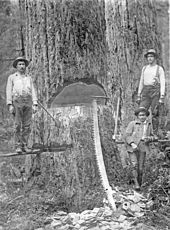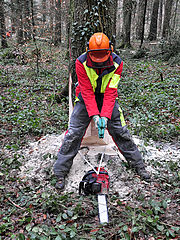Felling technique
Felling is a collective term for techniques by which to a tree in forest or tree maintenance work on the desired manner (e.g., as in a certain direction) brings to case ( drops ), or ablates. There are various cutting techniques for this . These and related techniques are also used in the processing of the tree - cutting it down into usable pieces of wood . With suitable cutting techniques and the correct use of tools, you can work effectively in forestry and even cut down a problem tree safely.
The standard felling technique is a combination of felling notch and felling cut . Trees are generally felled with a chainsaw . In the past, this was done by hand with a pull saw , ax and wedge , a more modern process is the wood harvester , or - in extreme situations - cutting from a helicopter .
Basically, a tree is not "sawn down", but, if it does not fall by itself, wedged , in Austrian also cut or laid .
Safety instructions for tree felling
For the felling of trees there is an accident prevention regulation (VSG) of the agricultural trade association .
Protective clothing
Cutting without protective clothing is life-threatening. The protective clothing includes:
- Safety shoes (reinforced heel, steel toe)
- Chainsaw protection pants
- working gloves
- Hard hat with visor
- Hearing protection on the hard hat
Special measures are required when processing live storm wood and stands infested by bark beetles because there is an increased risk of injury. There is also a particular danger with rotten wood or extreme frost because of the brittle wood, as well as with some woods outside the winter sap dormancy , because of the unpredictable behavior of the tree.
Danger zone
A circular area around the tree to be felled with a radius twice the tree length is designated as a danger area (see UVV Forests). Only those involved in the felling are allowed to stay in this area. Forest paths , hiking trails , etc. are to be cordoned off. Public roads must be closed in the event of danger (requirement: application for a traffic law order to the responsible district office ).
Assessments
Before the first cut, the tree must be carefully assessed ( tree approach ):
- Which tree species? Long-fiber tree species such as oak or spruce have a different fall behavior than short-fiber tree species such as Weymouth pine or beech .
- Is the tree upright or is it "hanging"?
- If it is hanging, is it a “clip-on” or a “counter-clip”?
- Where is the main crown load?
- In which direction do you want / have to let the tree fall?
- Does the tree show signs of stem rot or bark beetle infestation?
- Are the wind conditions suitable to generally cut trees safely?
- What dangers must be observed in the immediate vicinity (people, animals, traffic, power lines, buildings)?
- Which technical aids are necessary?
Depending on the direction in which the felling direction is and the direction in which the crown load is pointing, one speaks of a clip-on (hanging direction = falling direction), a side hanger (hanging direction offset at right angles to the falling direction) or a back-hanging (hanging direction opposite to the falling direction). The decision about the felling technique is made based on the hanging direction.
How are the wind conditions? As a rule of thumb: if thick branches move in the wind, the work is extremely dangerous and should be stopped if possible. If the wind is too strong, the tree to be felled cannot fall in a controlled manner.
If the tree to be felled has scarred injuries or open bark areas, core rot is to be expected. With rotten trees there is an increased risk of felling, as the tree is unstable due to the rot. If there are nails or other metal objects visible in the bark, there is a risk that the saw chain will break when it hits. Once all the factors have been assessed, it can be determined which technical aids are required. The standard equipment when felling a tree should be aluminum or plastic wedges with a splitting hammer , or a felling lifter in small wood . A multi-purpose hoist or rope on a tractor is always a good way to secure against tree felling.
For felling work in local areas, any existing tree protection statutes must also be observed.
In addition to the standard felling technique, there are other felling techniques such as felling with a heart cut (if the guide rail is too short), felling the retaining strap for curtains or felling with a support band for back hangers.
The precipitation

After cutting the roots , the notch is started.
The notch
The notch determines the direction of fall of the tree and enables it to tip in the desired direction. It consists of the drop notch base and the drop notch roof . Basically, the notch should be created under the trunk roll . The sole cut runs horizontally , slightly offset in height to the also horizontal cuts of the roots. It should be one fifth to one third the diameter of the trunk. The notched roof should have an angle of at least 45 ° (with a heart cut at least 60 °) to the base of the notched notch in order to have a sufficiently large opening. This ensures that the tree does not “sit down” too early with the notch roof on the notch base while it is falling, thereby causing the trunk to tear in the longitudinal axis.
The notched chord is formed at the intersection of the notched roof and the notched bottom; both cuts should meet. Neither of the two cuts should go beyond the other. The perpendicular of the string points in the direction of fall.
In long-fiber tree species such as spruce or pine , incisions are made in the trunk at the ends of the tendon in order to cut through the long outer wood fibers at the sole. The aim of the sapwood cuts is to prevent the trunk from tearing open to the side. This is not necessary for short-fiber tree species ( beech , etc.).
With curtains, the notched mouth is sawn on the side of the trunk towards which the tree is inclined and into which alone it can fall.
After creating the notch and checking the danger and retreat area again, the tree can be felled by felling.
Felling cut
The felling cut is made 1/10 of the trunk diameter, but at least 3 cm above the base of the felling notch. This height offset is called the fracture step.
When making the felling cut, care must be taken to ensure that a hinge, also 1/10 of the trunk diameter, but at least 3 cm thick, remains between the felling line and the felling cut. The hinge and step form a hinge that holds the tree in place during felling and guides it safely when it falls. The remnants of the hinge that remain at the lower end of the trunk after felling are called “ forest beard ”.
In the case of a tree that hangs strongly forward, a so-called retaining strap is left on the back of the tree. This is only cut through when the felling cut has been made. After cutting the strap, the tree falls.
Trees, with the exception of “curtains”, are always brought to the ground by setting a felling wedge .
Felling aids
Mechanical Fällhilfen ( Felling ) are leveraged tools that reduce the effort needed for tilting the tree. For stronger trees, wedges (plastic, aluminum) and a heavy hammer are used. Hydraulic felling aids can be used in thick wood to minimize physical strain.
See also
- Compressive stress
- Kickback effect
- Plumbing chop
- Rope-assisted tree climbing technique
- Tensile stress
literature
- Erlbeck, Haseder , Stinglwagner : The Cosmos Forest and Forest Lexicon. Kosmos-Verlag, 1998, ISBN 3-440-07511-7 .
- Manual working with the chainsaw. Husqvarna (excerpts as weblink ).
- Christoph Klose, Axenia Schäfer: The secrets of professional tree felling: The extensive work on working with the chainsaw. Verlag Schäfer & Schäfer, 2019, ISBN 978-3-982-06103-0 .
Web links
- Forest - Media of the Federal Association of Accident Insurance Funds
- waldwissen.net : Risks in forestry activities
- waldwissen.net : Felling technology for hardwood
- Videos about the drop notch system and the felling technique
- Felling a tree, instructions, visibility instructions, sawing knowledge and stick bearing
- Film: The security incident technique - felling technique of the professionals, SVLFG
Individual evidence
- ↑ The flying saw
- ↑ VSG Waldarbeit ( page no longer available , search in web archives ) Info: The link was automatically marked as defective. Please check the link according to the instructions and then remove this notice. (PDF, 10 MB)






